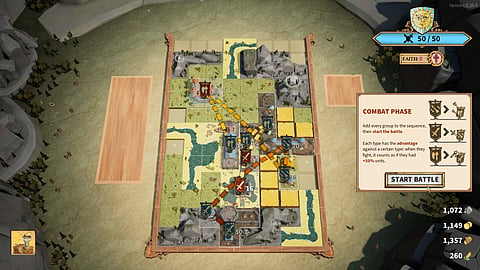

In a post-Balatro world, the roguelike deckbuilders have seriously upped their game. So when “Drop Duchy” was released a few months ago, I couldn’t help but try it out. Drop Duchy is exactly what you would expect from a game in the same genre — it’s a simple, but well-built idle game. An idle game is what I can play when I listen to a podcast or an audiobook. It takes up half of your focus, because it is mostly just a combination of muscle memory and inconsequential decisions. And in a post-Balatro world, it needs a shiny new gimmick. So while Poker largely inspires Balatro, Drop Duchy chooses Tetris as its baseline mechanic. You would assume that Tetris has an easier learning curve when compared to Poker. Because Poker requires you to know maths, and Tetris just wants you to understand shapes. But Drop Duchy is cooler than that — it adds five additional layers of complexity to your normal game of Tetris, so that it barely resembles the original game.
So what is it? As the name suggests, you must expand your duchy. You own a small piece of land that needs to be carved out to provide you with the right combination of resources. If you are someone familiar with board games like I am, you might notice that creating a continuous strip of similar terrain forms will reap higher benefits. Think Carcassonne. Similarly, the game incentivises you to group shapes of a similar terrain together - rivers bind with rivers, forests with other trees, and plains with fields.
When you see the different shapes falling from the top of your screen, you must make one of two choices. Your first option is to optimise for the “tetris”ness of it all. Clean horizontal lines, no gaps in between. The horizontal lines give you a nice bonus to your resource horde. The second, and probably more sensible option, is to optimize for resource collection — this would mean that you tie different shapes together, not based on completing the rows on your grid, but to make a continuous piece of land that can then be harvested by special cards. Special cards are buildings — mills, quarries, markets - which all try to get the best out of the resource cards that you have so beautifully placed.
The ultimate goal of Drop Duchy is to eventually build a strong kingdom that is capable of attacking the big bad “wall”, which consists of opponents that try to attack your duchy. In the process, resource harvesting must be optimized to get the right combination of “Attack” cards — or military reinforcements. After all, this is a deck-building game. Playing the game enough times unlocks a sufficient pool of cards to choose from, which increases your chances of winning. Buying cards or upgrading them can get you better benefits, which also helps in defeating the enemy in the final boss battles. Placing the attack cards around its linked biomes also gets you better benefits. There are special attack cards which reinforce the ally's strengths, and all of this combined with its art style reminded me a bit of Clash of Clans (without the microtransactions).
Drop Duchy is overall a solid deckbuilder, which would probably play much better as an actual physical board game, as the upgrade elements and cards are fairly limited. It’s no Balatro — and I haven’t found a roguelike deckbuilding game to equal its fame and sensation just yet. But I will persevere. Drop Duchy is a single-player game available only on the PC via the Steam Store. It’s worth a try if you, too, are looking out for the next best deckbuilding sensation and want to test them out.